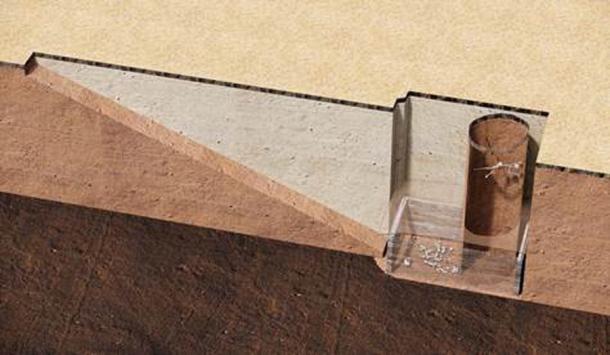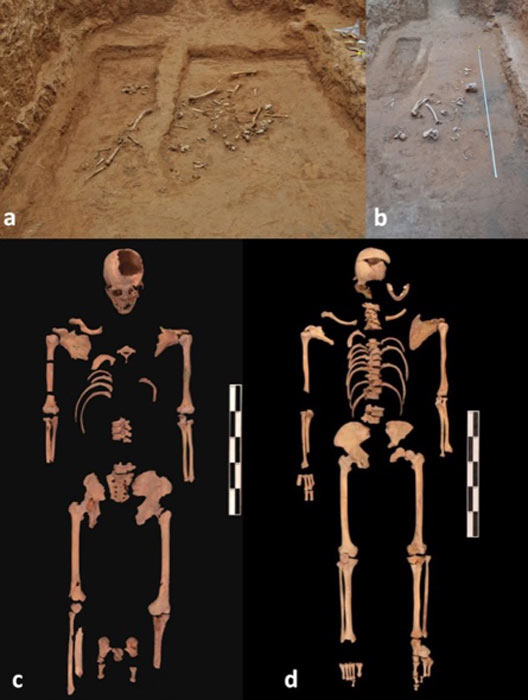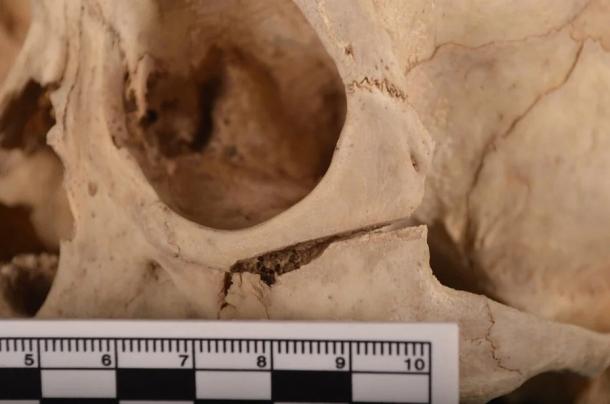While his killer(s) will never be brought to justice, a new study published in Archaeological and Anthropological Sciences has cleared the memory a young man who died 1,300 years ago in the northwest autonomous region of Ningxia in China. Experts previously believed he was a grave robber, who accidentally fell into a grave within a Shiyanzi cemetery while trying to rob it. Now however, a team of scientists from Texas A&M University has established that he was actually murdered and thrown into the grave to hide the crime.

The supposed grave robber was discovered in a vertical robbery shaft leading down to a 2,000-year-old tomb in China. ( Zou et. al. / Archaeological and Anthropological Sciences )
Discovering the Body and Being Branded a Grave Robber
The Shiyanzi cemetery was discovered by construction workers laying a pipeline through the northwest autonomous region of Ningxia in 2002. The cemetery, which is 2,000 years old, is from the Eastern Han Dynasty period (202 BC – AD 220). Excavation work began there in 2009, uncovering a total of 11 tombs, before archaeologists began digging up the remains of each individual tomb.
The man’s body was found in 2011 in a grave along with three other skeletons. The three skeletons were found to be members of one family unit, while the young man was no relation at all. Dr. Wang Qian of the Department of Biomedical Sciences at Texas A&M University and lead author of the study, told South China Morning Post that the family seems to have been very well-to-do.
“The grave goods must have been very rich, which led to a large-scale grave robbery evidenced by the vertical robbery shaft,” explained Dr. Wang. Nevertheless, the cemetery had been systematically cleaned out of all valuable grave goods over time. During excavations the man’s almost complete skeleton was found lodged in a shaft used by grave robbers to reach the bounty.
Bone analysis proved the skeleton was 700 years younger than the other inhabitants of the grave. This led to the not unnatural first impression that the man had fallen in and died of accidental injury while robbing the grave. As the authors of the study wrote, “the individual in the grave-robbing shaft was initially presumed to be a grave robber .”
The image of a grave robber caught in the act was supported by other examples from Chinese history. One was the case of a skeleton from the Tang dynasty (618 to 907) that was found in a tomb built during the Ming dynasty (1368 to 1644). The Ming dynasty skeleton was 800 years younger than the original inhabitants of the tomb and it was concluded that he had been killed when the tomb collapsed while he was robbing it.
Although strictly prohibited by law, a tradition of “official” grave robbery existed in China whereby the plunder of graves was sponsored by the government and military to fund expenditures. One example being Cao Cao , a warlord from the Three Kingdoms period who ordered his army to rob graves to raise money for the army.

The Shiyanzi “grave robber” was discovered along with the much older remains of three individuals within the tomb. (Zou et. al. / Archaeological and Anthropological Sciences )
Clearing His Name – Posthumously
However, the suspicion of grave robbing proved to be unjust as far as the Shiyanzi skeleton was concerned. Once bone analysis had determined the age of the skeleton, the scientists tried to establish what had caused his death 1,300 years ago.
They found there were 13 “V-shaped sharp-force marks” on the skeleton, with the deepest being on the face. However, although deep enough to have caused pain and bleeding, they couldn’t have been fatal. It was the stab wounds to the ribs which could have injured a vital organ and likely caused his untimely demise.
Injuries to the back of the head suggest that the man was attacked from behind. There were also force marks on the legs and arms suggesting that the man was trying to defend himself while being attacked. The authors said that it was clear that the injuries came from a sharp-edged weapon and not a blunt one like a club or rock. The picture that emerges is of the victim facing a sustained attack and being stabbed multiple times, rather than that of a grave robber .
The authors of the study felt that the man had died outside the tomb, before bring thrown into the shaft, although he could have been thrown in and then died. However, the state of the shaft, half filled with soil and animal remains, indicated that the shaft had been out of use for centuries before the purported grave robber died.

Close up of the injuries sustained by the Shiyanzi man which experts believe proove that he was a victim rather then the perpetrator of a crime. ( Zou et. al. / Archaeological and Anthropological Sciences )
This indicates that the man couldn’t have been part of the team that built the shaft with the purpose of plunder. Another thing that seems to point to his innocence was that the man was found 4.5 metres (14.7 ft) above the original chamber of the tomb, far from the grave goods.
Crimes of murder and assault causing grievous injury invited capital punishment by decapitation and hanging during the Tang era, when the Shiyanzi man came to his end. Therefore, the perpetrators would have needed to dispose of the body in such a way as to avoid detection.
“After the assault, the victim was dumped in this shaft to be purposely kept from sight. This case indicates that the strategy of hiding victims’ bodies in existing tombs or graveyards as a means of disposal, akin to ‘hiding a leaf in the forest,’ has been practiced since antiquity,” the authors concluded in the Archaeological and Anthropological Sciences study.
Top image: The Shiyanzi grave robber discovered in China. Source: Zou et. al. / Archaeological and Anthropological Sciences
By Sahir Pandey
Related posts:
Views: 0
 RSS Feed
RSS Feed

















 October 28th, 2021
October 28th, 2021  Awake Goy
Awake Goy  Posted in
Posted in  Tags:
Tags: 
















